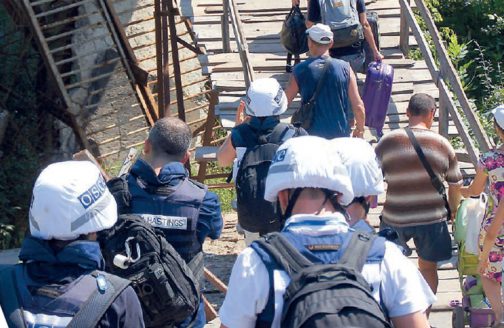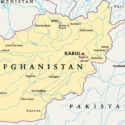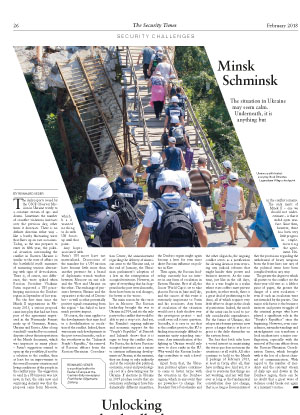The situation in Ukraine may seem calm. Underneath, it is anything but

The daily reports issued by the OSCE Observer Mission in Ukraine testify to a constant stream of ups and downs. Sometimes the number of ceasefire violations increases over the previous day; other times it decreases. There is no definite direction either way – like a barely fluctuating wave that flares up on rare occasions. Today, as the war prepares to enter its fifth year, the political situation surrounding the conflict in Eastern Ukraine is similar to the state of affairs on the battlefield itself: moments of mounting tension alternating with signs of de-escalation. There is, of course, one difference; this wave spiked when Russian President Vladimir Putin requested a UN peacekeeping mission in the Donbass region in September of last year.
For the first time since the Minsk II negotiations in February 2015, a serious proposal came into play that had not been part of the agreement negotiated in the Normandy Format made up of Germany, France, Ukraine and Russia. After a long standstill – marked by occasional disputes about the interpretation of the Minsk document, which was imprecise in many places – Putin’s suggestion seemed to open up the possibility, if not for a solution to the conflict, then at least for an improvement to the overall security situation and living conditions of the people in the conflict zone. The suggestion to send in a UN mission was not new; in fact, the only new and surprising element was that the proposal came from Moscow, which h a d wanted nothing to do with UN forces up until that point.
Any hopes associated with Putin’s UN move have not materialized. Discussions of the mandate for a UN mission have become little more than another pretense for a brand of diplomatic trench warfare between Moscow on one side and the West and Ukraine on the other. The exchange of prisoners between Ukraine and the separatists at the end of December – as well as other potentially positive signals emanating from the region – has failed to have much positive impact.
Of course, the same applies to the developments that may lead to a destabilization or escalation of the conflict. Indeed, there were many such developments in the past several months, such as the overthrow in the “Luhansk People’s Republic,” the removal of Russian officers from the Russian-Ukrainian Coordination Center, the announcement regarding the delivery of American arms to the Ukraine and, at the end of January, the Ukrainian parliament’s adoption of a law on the reintegration of occupied territories. However, in spite of everything that has happened in the past several months, there have been no real changes, for better or for worse.
The main reason for this stasis lies in Moscow. The Russian leadership brought the war to Ukraine in 2014, and it is the only party to the conflict that would be able to put a stop to it. And yet, the Kremlin’s ongoing military and economic support for the “People’s Republics” of Donetsk and Luhansk shows that it is eager to keep the conflict alive. For Russia, the de-facto Russian-occupied territories are a means to continue influencing developments in Ukraine; at the moment, they are doing so only indirectly and at the considerable political, economic, social and psychological cost of a devastating war for Ukraine. If elections in Ukraine in 2019 produce results that are even more confusing or have fundamentally different majorities, the Donbass region might again become a lever for even more direct Russian influence on politics in Kiev.
Then again, the Russian leadership currently has no interest in any form of escalation in Eastern Ukraine. First of all, the Soccer World Cup is set to take place in Russia in June and July, and the success of this event is extremely important to Putin and his associates. Any form of escalation of the situation would cast a dark shadow over this prestigious project – and could even call it into question. Secondly, it is easy to see that as the conflict persists, the EU is finding it increasingly difficult to maintain unity regarding sanctions. Any intensification of the fighting in Ukraine would only serve to close ranks in the EU. Why would the Russian leadership contribute to such a development?
Apart from that, the Ukrainian political sphere continues to come to better terms with the situation in the Donbass region, which in any event they are powerless to change. For President Petro Poroshenko and the other oligarchs, the ongoing conflict serves as a justification for slowing down or even reversing any judicial reforms that might hinder their power and business interests. At the same time, just like in the old days, this is a war fought in a realm where state coffers meet private pockets; in other words, there is a great deal of profiteering to be done, all of which requires very little effort to drape in the cloak of patriotism. Indeed, the needs of the army can be used to justify considerable expenditures. For the future of Ukraine, this relapse into former patterns now poses a danger that is at least as great as the daily skirmishes on the eastern front.
The fact that both sides have a vested interest in maintaining the status quo does not mean the situation is at all stable. All sides continue to hold to the Minsk II package of February 2015, at least in form; after all, they have nothing else. And yet, it is clear to everyone that things are not working, and nor will they ever as long as the fundamental constellation does not change, that is, as long as Russian interest in the conflict remains. The only merit of Minsk II – one we should not underestimate – is that it ended open warfare. Since then, however, there has been very little progress in implem e n t i n g the agreement. Neither the provisions regarding the withdrawal of heavy weapons from the front lines nor any of the political items have been complied with in any way.
The greater the degree to which all parties to the conflict see the three-year-old text as a lifeless piece of paper, the greater the danger of a new escalation – even if such an escalation were not intended by the parties. One major risk factor is the business interests and power struggles of the criminal groups who have played a significant role in the “People’s Republics” since the beginning. However, even coincidences, misunderstandings and misjudgments can transform a local incident into a major conflagration, especially with the removal of Russian officers from the Russian-Ukrainian Coordination Center, which brought with it the loss of a direct channel of communication. With regard to the number of incidents and the constant stream of daily ups and downs in the Donbass region, there can be no doubt that a great wave of violence could break out again at a moment’s notice.
REINHARD VESER
is a political editor for Eastern Europe at the German daily newspaper Frankfurter Allgemeine Zeitung




